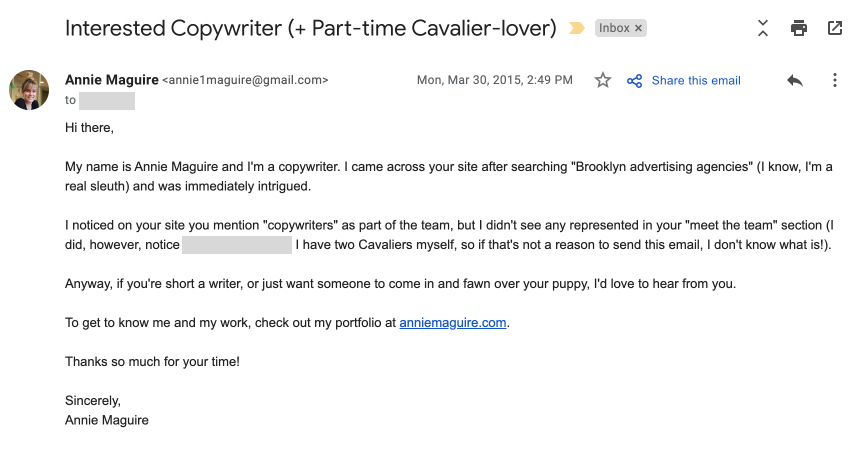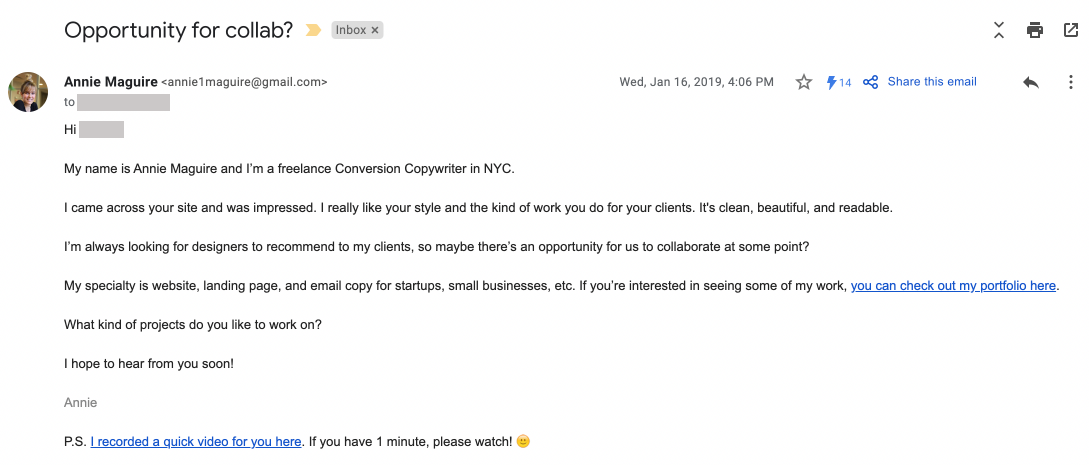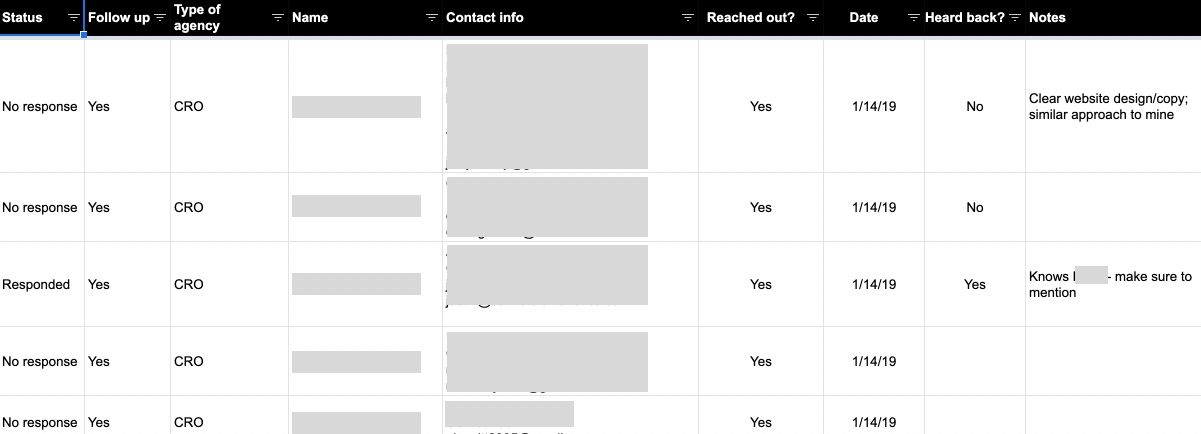This is a guest post written by Annie Maguire. Annie is a copywriter who specializes in content strategy, customer research, and conversion. For over a decade, Annie has worked on brands like USA Network, Smirnoff, Guinness, Ben & Jerry’s, Clinique, and many others. For the last 7 years, Annie’s been running her own freelance business helping businesses of all sizes capture and convert more leads. Take it away, Annie!
When I started my freelancing business, I had no clients and no way of making money.
With no connections or contacts, I decided to try cold emailing to see if I could drum up some business.
To my surprise, I quickly got responses from two different agencies who became my first clients.
One of them was a client for six years (yes, six years!). The other, I’m still in touch with today (in fact, he just reached out a few weeks ago).
These days, most of my business comes from word of mouth, but I still use cold emailing as a way to build relationships and occasionally find work.
Why? Because whether you’re just starting out or you’re fully established, cold emailing works.
I’m Annie Maguire and I’ve been a copywriter for over a decade and a freelancer for seven years. I also teach ambitious professionals how to quit their jobs and start their own freelance businesses with confidence and clarity.
In this article, I’m going to share with you the exact approach, tools, and templates I used to find my first clients and many more after that.
But before we get to the templates and tools, let’s talk about the people who will be receiving your cold emails: the potential clients.
Who should I reach out to?
Before you can send any cold emails, you need a list of potential clients. But how do you know who should be on your list?
The answer to this question depends on what you’re selling. For example, as a freelance copywriter, I knew I could find clients through agencies.
Agencies are always pitching new business and usually need extra help, so they’re a great connection to have if you’re new to freelancing or looking for work.
To make my list of agency contacts, I went on Google and searched for marketing, advertising, design, and branding agencies in my area that I wanted to work with.
I reviewed each site, made a note of what I liked (or why I wanted to work with them), found the best person to contact (usually the founder or the head of the department I wanted to work with) and reached out.
Again, this is the exact approach that landed me two long-term clients who have since collectively paid me thousands of dollars. It’s also gotten me countless meetings, interviews, and other projects throughout my freelance career.
When I saw how well this approach worked with agencies, I started using it to build relationships with other freelancers, as well.
I followed the same process: I made a list of the freelancers I wanted to work with (in my case, designers, developers, writers, etc) went on Google (or relevant sites like LinkedIn, WorkingNotWorking, Behance, Twitter, Instagram, etc), got their contact info, and reached out.
For your business, think about the kind of people who may have a need for what you’re offering.
For example, if you’re a designer/developer, try reaching out to businesses who have outdated websites and offer your services. If you’re a content writer, look for websites with blogs that haven’t been updated in a while and see if they’d like fresh content. If you see a terrible ad on Facebook, reach out to the business and tell them how you’d make it better.
It’s all about pairing your expertise with a need and framing it in the right way; they may not need your services right away, but that doesn’t mean they won’t need you in the future.
And remember, cold emailing is a numbers game. Not everyone will respond or say yes, but the few who do will often lead to money-making opportunities.
What should I say in my cold email?
If you want your cold emails to work, they must be genuine.
This means addressing a specific person (or persons) by name and including something in the email that gets them to pause and actually read it.
In my case, I found the most success with the following structure:
- Personal greeting: Address the person(s) by name
- Introduce yourself: Who you are/what you do/why you’re reaching out
- Moment of admiration: Why you’re interested in working together (get specific!)
- How you can help them: And include a link to your site/portfolio/samples
- Sign-off: Thank them + let them know you hope to hear from them soon
To show you how it works, check out the example below which is the email I used to get one of my first clients (note the date, 2015!):

In this example, I’m using the 5 basic elements from the bulleted list above, but I added information that was specific to the prospect to capture their interest and build a personal connection.
When reaching out to other freelancers with complementary skills, I’ve found that it’s very effective to frame your subject line and message with the concept of collaboration (i.e. “Potential collab?”).
For example: “I’m often looking for developers I can recommend to my clients, so it would be great to learn more about your process, pricing, availability, etc”
Ideally, you should have clients who may need their services, but the hope is that they, too, have clients who may need your services, either today or in the future.
Another tactic that’s worked for me is including a “P.S.” with a personalized, 1-minute video introducing yourself and explaining why you’d like to work with them.
Check out the example below to see that approach in action:

Adding that personal touch led to two very important relationships in my freelance career.
Through those relationships, I got a ton of experience, three amazing case studies, and made a lot of money in the process (not to mention the friendships!)
What tools should I use?
Cold emailing can be a time and energy suck, so it’s important to use tools that help you save time while also relieving stress and headache.
When I first started cold emailing I didn’t use any tools, which saved me a little bit of money, but it certainly didn’t make my life any easier.
As I gained more experience, I started using paid tools to make my process faster, more efficient, and less painful.
The tools cost me less than $100/month and have landed me projects worth hundreds of thousands of dollars combined, so for me, the tools are well worth the investment.
Below I breakdown which tools I use (and for what purpose) so you can decide if they’re right for you at this stage of your business.
Tools for finding contact information
When hunting down contact information, I always start with Google or public sites (like the person’s website, social media profiles, LinkedIn, etc) which may list their contact info.
If you can’t find someone’s contact information the old fashioned way, I recommend using RocketReach, a database that has just about everyone’s contact info.
While it does cost money (the lowest plan is about $50/month), there is a free trial that will give you a few contacts for free.
Often I’ll sign up for a month, get all of the contacts I need, then pause/cancel my subscription so I’m not being charged for the months that I’m not using the service.
It’s a pretty easy and reliable way to get the information you need, especially when you’re in a rush.
Tools for storing your cold email contacts
As you search for contacts, you’ll inevitably need a place to store them so you can keep track of people’s names, email addresses, titles, companies, or anything else that may be relevant.
You’ll also want to keep track of when you reached out, when to follow up, if/when they replied, the status of your conversation, and more.
To do that, I use Mixmax, an email/CRM tool that’s great for tracking the aforementioned.
The software does cost money (the price ranges depending on what you need), but if you prefer the unpaid route, you can do something similar using Google Sheets (just create a spreadsheet and input/track your contacts manually – I did this for at least two years. Below is a snapshot from my own cold email CRM spreadsheet).

Tools for tracking engagement, storing your cold email templates & more
One of the toughest things about cold emailing is not getting a reply.
When this happens, you’re left wondering if the email was read (or even delivered) which can make following up a little more scary or challenging.
To avoid that, I use Mixmax to track the engagement (meaning clicks, opens, etc) on my emails.
With Mixmax, I can see if the email was delivered, if it was read (and by whom/when/where), and how many times it was viewed.
Having this information is critically important as you decide where to spend your time and energy.
For example, if I see that PersonX read my email three times, but PersonY never opened it, I’m probably going to have more luck with PersonX and should adjust my follow-up strategy accordingly.
Mixmax also allows you to store your cold email templates so you can keep them all in one place and easily adjust them for each person you’re contacting.
This makes the process faster as you’re wasting less time rewriting the same email and more time customizing your template for each person.
I also use Mixmax to save my outbound email templates (which I use when leads reach out to me); this has saved me countless hours of manually responding to dozens of leads per day.
While there are some free solutions out there that offer email tracking, I’ve found that Mixmax is the easiest and most reliable.
If you don’t need email tracking (and don’t want to pay just to store your email templates), Google Docs or a notes app works great, too.
When should I reach out?
Timing may vary depending on your industry and offering, but in general, I tend to avoid sending cold emails during the holidays or at the end/beginning of the year.
Instead, reach out during times when your services may be needed the most or when you know the person may have downtime.
For example, businesses aren’t usually hiring in December/January, but may be more open to hearing from you in February/March/April as they start kicking off or planning for big projects.
Another good time is usually September/October/November as businesses gear up to hit their end-of-year goals. These are also great months to discuss projects that may begin the following year.
Early summer (June/July) can also be a great time to build connections and relationships; in my experience, work tends to slow down a little bit and people are happier and may be more open to responding to an email or scheduling a call.
You may have some difficulty during August (since a lot of people are on vacation or getting ready for school) but it never hurts to try.
Of course, the most important thing is knowing the typical timelines for your industry.
For example, the schedule for fashion, retail, education, entertainment, etc may be very different from, say, a SaaS company or a company that sells car washing services or flip flops.
It’s all about knowing what’s happening in the lives of your potential clients so you can be strategic and increase your chances of success.
One final tip: Always follow up!
While it may seem scary at first, don’t be afraid to follow up, especially if you can see that someone has read your email one or more times.
Obviously you don’t want to harass people, but I think it’s OK to follow up at least 1-3 times, especially if you spread the emails out (i.e. – if you don’t hear from them within a week or two, try following up in a month or later in the year).
For those who aren’t interested in working together, you can also encourage them to subscribe to your newsletter or to follow you on social media so you can stay in touch. You never know – they may reach out in a year or two when they need you (this has happened to me many times).
If you’re interested in more freelance tips, check out my book, From Full-time to Freelance.
Wishing you all the best on your cold emailing journey!

